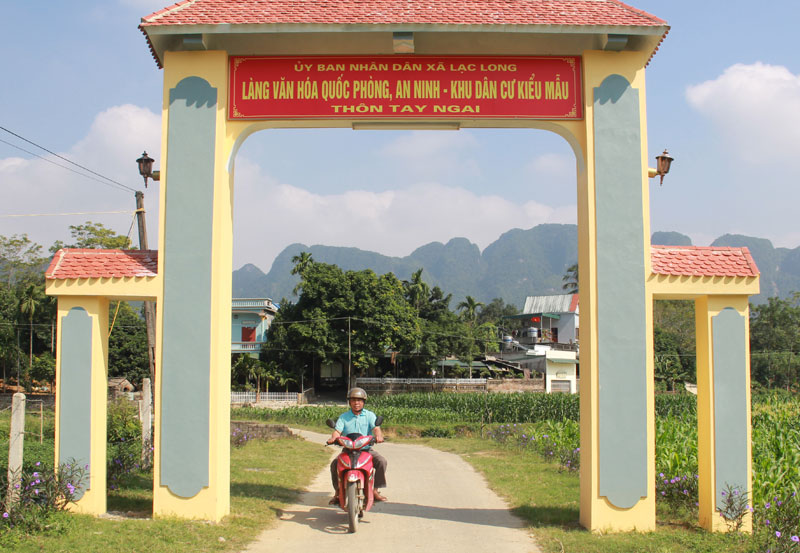
(HBO) Residents in TayNgai hamlet, Lac Long commune of Lac Thuy district are actively participating in a new-style rural area development programme which helps promote infrastructure systems and improve their living conditions.
Laughter of locals calling oneanother to work fills the roads fromthe gate to the inside of Tay Ngai village.
The village now counts 98 households with 353 inhabitants. Before 2011, when the programme was not implemented, the life of locals was full with difficultieswhileinfrastructure facilities did not meet the demand.
joining the programme, locals in Tay Ngai village, Lac Long commune, Lac Thuy district contributed over 20 million VND to build the gate of the village.
Facing thesituation, the village’s management board actively promotedcampaign to raise public awareness of the programme.
It also encouraged local people to donate their land, cash and working days to build works that they directly benefit.
Typically, 19 households donated more than 2,500 sq.m of land for building rural roads;local people also contributed more than 20 million VND to build the village’s gate; 6 million VND for leveling and filling the village’s roads, and nearly 23 million VND for building a concrete yard of the cultural house.
To raise the per capita income and reduce the number of poor households in the hamlet, locals have converted the inefficient tea growing areasinto those for planting citrus trees, with 40 ha of orange and grapefruit.
At the same time, the locality maintained the 15 ha for the cultivation of Shan Tuyet tea, and 39 ha of water rice.
Tay Ngai hamlet was chosen as a pilot locality in the district in the project "Don dien doi thua”, which welcomes the exchanging of small farming plots for a better reallocation of agricultural lands. The hamlet’s management board has taken many creative ways to help locals understand more about the policy.
Thanks to these efforts, the villagers’ average annual per capita incomehas been increased to 35 million VND, while the rate of poor households brought down to 8.1 percent.
All the rural transport roads have been concreted or asphalted, while 90 percent of the roads linking fields have met the demand of agricultural production mechanization.
The hamlet’s cultural house has beenupgraded witha wall and a sports ground covering 1,000 square metres.
The rate of villagers employed has reached 90.8 percent; 100 percent of households have accessclean water sources and 84.1 percent of local households are recognised as cultural families./.
The Department of Education and Training of Hoa Binh province held a conference on March 18 to review the performance of the "Safe and Happy School" Project and set out tasks for 2025. The project, funded by the Taiwan Fund for Children and Families (TFCF), aims to create a safe, inclusive, and supportive learning environment for students. The event saw the attendance of representatives from the TFCF and 26 beneficiary schools.
With over 70% of their workers being women, trade unions across industrial parks (IPs) in Hoa Binh have been actively safeguarding their legal rights and interests while implementing initiatives to improve their income and well-being.
In recent years, the Hoa Binh provincial General Hospital has continuously innovated itself and improved the quality of medical services to meet the increasing needs of local people. With substantial investments in infrastructure and modern equipment, along with a team of highly qualified doctors and nurses, the hospital has gradually established itself as one of the leading medical units in the Northwestern region and a trusted destination for healthcare for people inside and outside the province.
From mastering the fundamentals of programming to achieving national recognition, the Programming Club of the Le Van Tam Primary School (STAR LVT28) in Hoa Binh city has made remarkable strides in the field of robotics.
The Ho Chi Minh Communist Youth Union Committee and the Vietnam Youth Federation chapter of Hoa Binh province organised a programme on March 12 to launch the "Digital Literacy" movement and an online quiz on the resolutions of the Vietnam Youth Federation congresses at all levels, as well as the Politburo's Resolution No. 57-NQ/TW on breakthroughs in the development of science, technology, innovation, and national digital transformation.
As climate change grows more unpredictable, the development of production forests has become essential - not just for economic growth, but for safeguarding the environment and maintaining ecosystem balance. By boosting local incomes, curbing natural disasters, preventing soil erosion, and protecting water resources, these forests play a crucial role in sustainable development.



